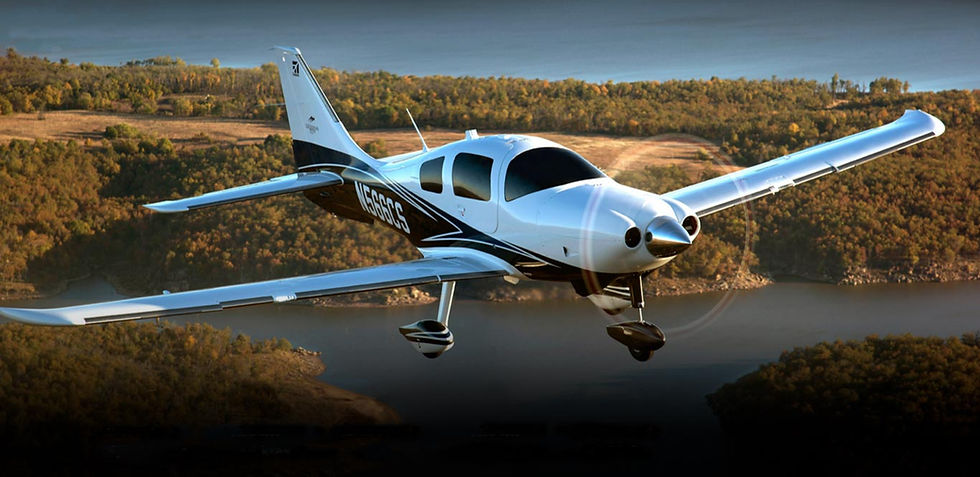"Above the planet on a wing and a prayer
My grubby halo, a vapor trail in the empty air
Across the clouds I see my shadow fly
Out of the corner of my watering eye
A dream unthreatened by the morning light
Could blow this soul right through the roof of the night
There's no sensation to compare with this
Suspended animation, a state of bliss
Can't keep my mind from the circling sky
Tongue-tied and twisted, just an earth-bound misfit, I"
-David Gilmour, Learning to Fly

The flight began uneventfully yesterday morning. Not a cloud in the sky, cool air, about ten knots of headwind--the Columbia practically leapt off the runway at 75 knots, as if being released from the boredom of sitting on the tarmac at KFPY for two weeks.
Passing over Puckett Road I pulled up the flaps, engaged the autopilot, and started dialing in a climb speed of 130 knots to keep the cylinder heads nice and cool. Rather suddenly, a sharp stabbing pain started to gather on my left side, about halfway down my abdomen. It felt like the worst cramp you ever experienced as a child running around on a full stomach, only ten times worse. I curled over, then tried to stretch upward to release whatever it was that was relentlessly pulling me into a ball. We were maybe 400 feet above the trees.
"What's wrong?" P picked up on the odd body language and the suddenly labored breathing.
"Do we need to turn back?"
At this point I couldn't really answer, the pain was so intense, as I pondered her question. It would be some fancy flying to yank the Columbia back around in a circling maneuver and bring it down, maybe on Runway 30 instead of 36 so I'd have a little room to pull off the turn.
Even as I mapped the turn in my head, I could feel whatever it was that had grabbed my innards was beginning to let go, ever so gradually. I tried to pull a little more upright, but it pulled back, letting me know we weren't quite done yet. The airplane on autopilot will just sort of drone in a straight line if you don't tell it where to go, so I turned the heading bug toward our destination, Panama City, and pushed the "HDG" button on the instrument panel. The Columbia continued its climb, and began a gradual left turn to the west. I figured Peg would be better off droning along level at 4500 feet if I passed out than if I was in the midst of a tight turn just about stall speed and just above the fire station.
Within a minute it was all over. Whatever had grabbed me let go, leaving only the sensation of a deep bruise on one side. I wasn't sure what had just happened, maybe won't ever know, but the event sparked a conversation in the cockpit.
Up to then P had never expressed much interest in learning to land, preferring in the abstract the image of the two of us going down together if I had a Sudden and Massive somewhere over the Shenandoah. But yesterday brought home that I could have some health issue in flight that renders me unable to fly the plane, maybe even unconscious. And then what? Maybe if she could land she'd not only save herself, but me if I'm not quite over the rainbow bridge at that point?
So on the way to ECP I started talking her through what to do if this condition of mine returned during the remaining twenty-six minutes of flight. Push the red knob (mixture) full forward--it'll make sure the propeller keeps turning. Same with the blue (propeller) knob. The black knob (manifold pressure) is now your throttle--just like a car. Pull it back to 24 pounds per square inch, which is a nice midrange setting.
Now get ready to descend--Rotate the altitude knob down to 1500 feet (1400 feet above the ground in Panama City, more or less). Push the "VS" button (vertical speed), then hit the "Nose Down" button five times. That'll give you 500 feet per minute in the descent. The plane will get fast, but don't worry about that now. Push the red button on the stick and tell the controllers what's going on. They'll be a great resource as you approach the field.
Cross over the top of the field and push the other red button on the stick to kill the autopilot, and start turning to line up with the runway. The plane should start slowing down a little. Once you're lined up, turn the MP back to 12 and start pulling back on the stick as the airplane slows. At 120 knots drop one detent of flap, point the bug on the instrument panel at the picture of the approach end of the runway, and start down. As you feel the runway coming up to meet you, pull the throttle to idle and start easing back on the stick. It may be a fast and ugly landing, but it'll be a landing. The brakes are on the tops of the rudder pedals--just ease your toes up there and stop straight ahead. There will be a firetruck waiting there to help you exit and remove what was once me.
Sounds complicated, but really it's not. We're going to make it a routine to do an instructed landing every time now, having Peg follow on the stick and the various switches. We're hoping she never has to prove proficiency, but yesterday reminded us it's crazy not to be prepared.
Comments